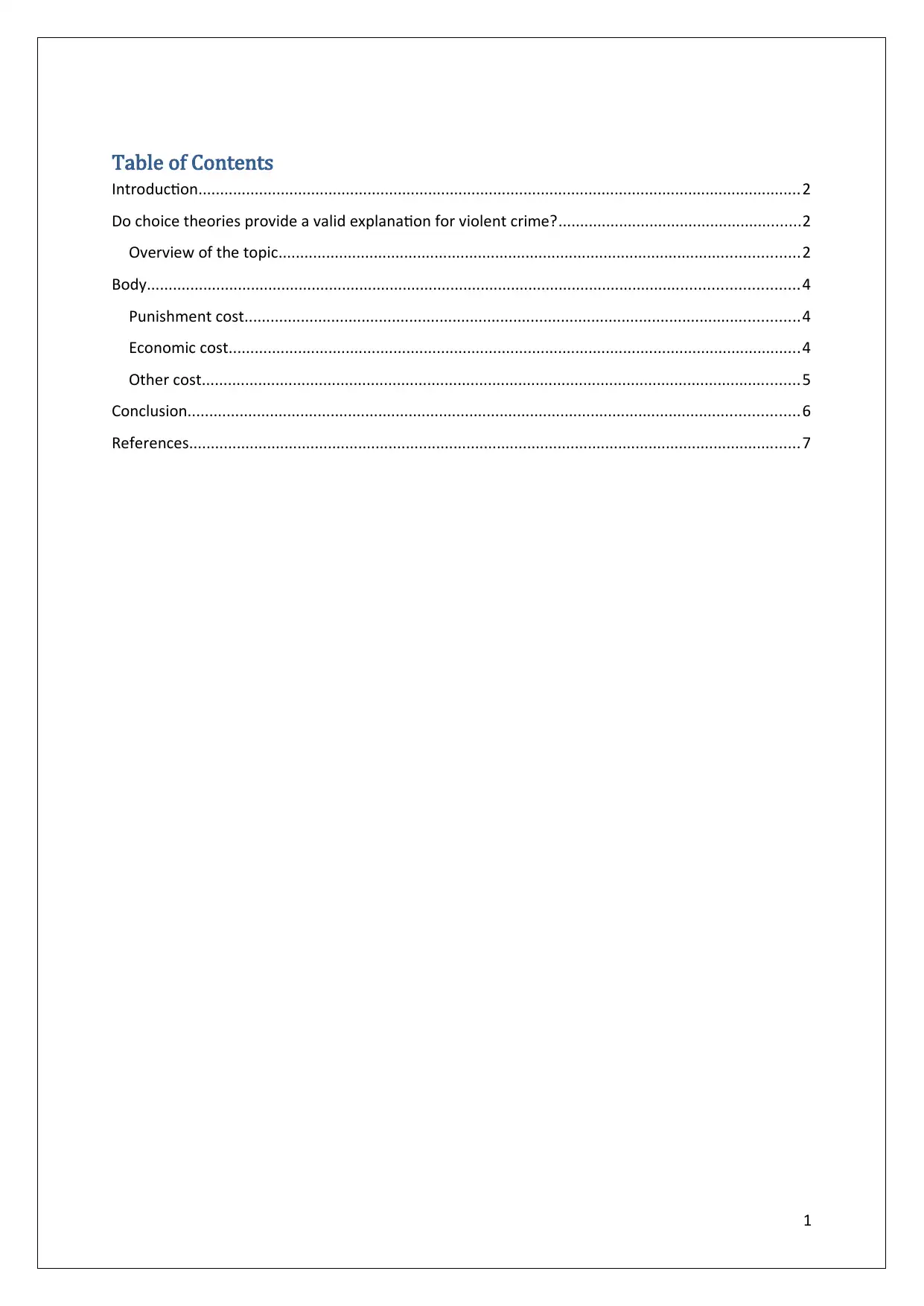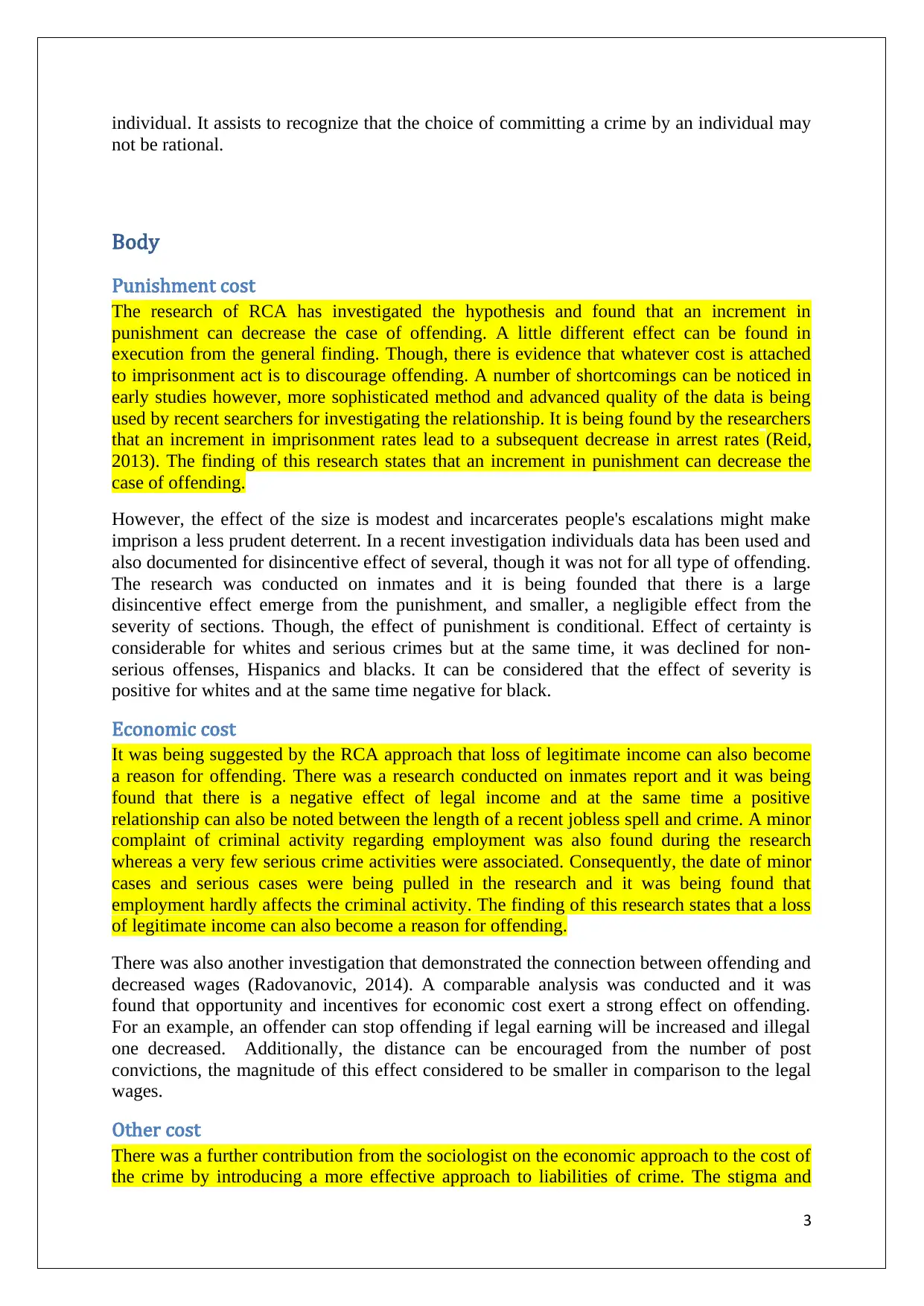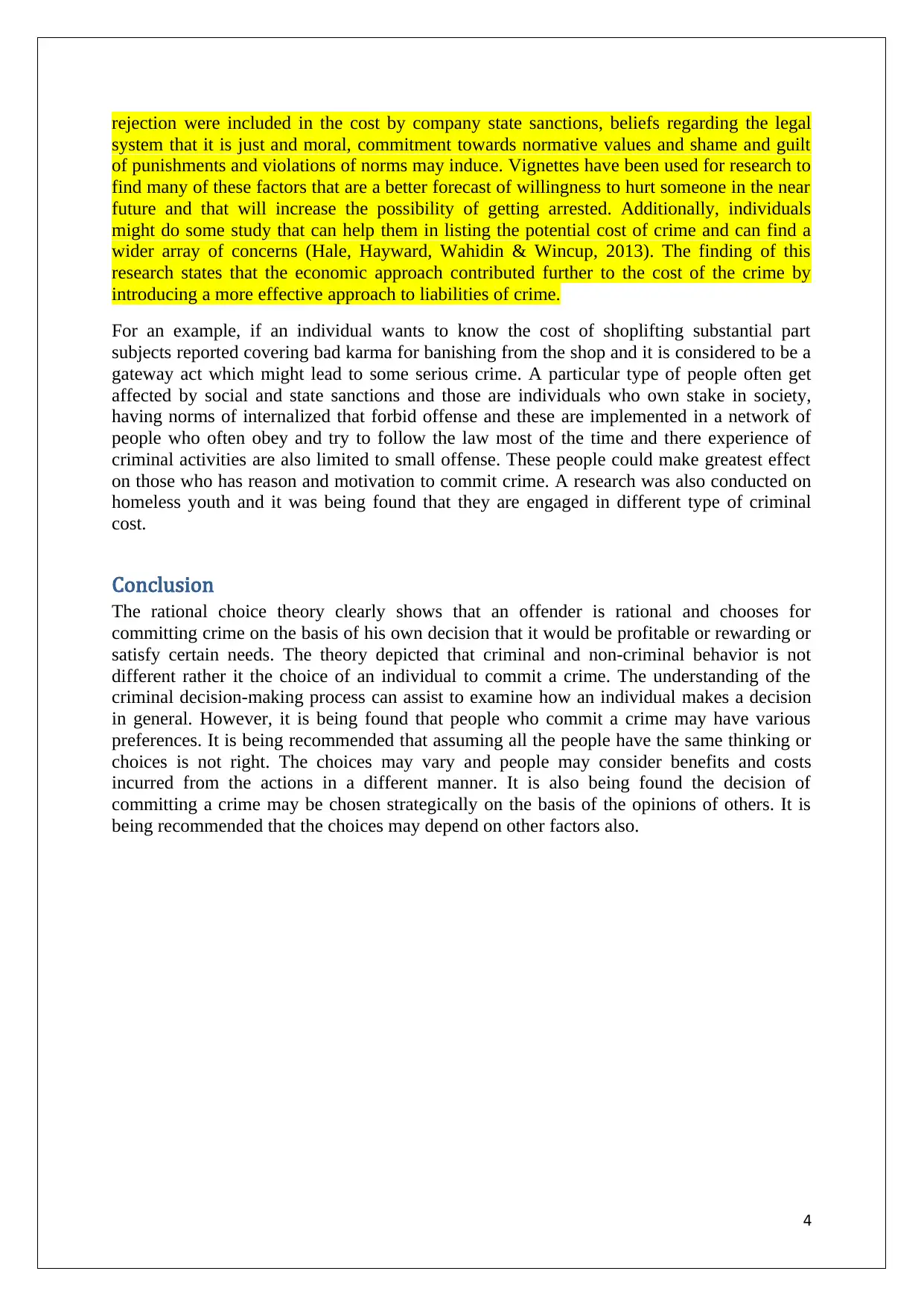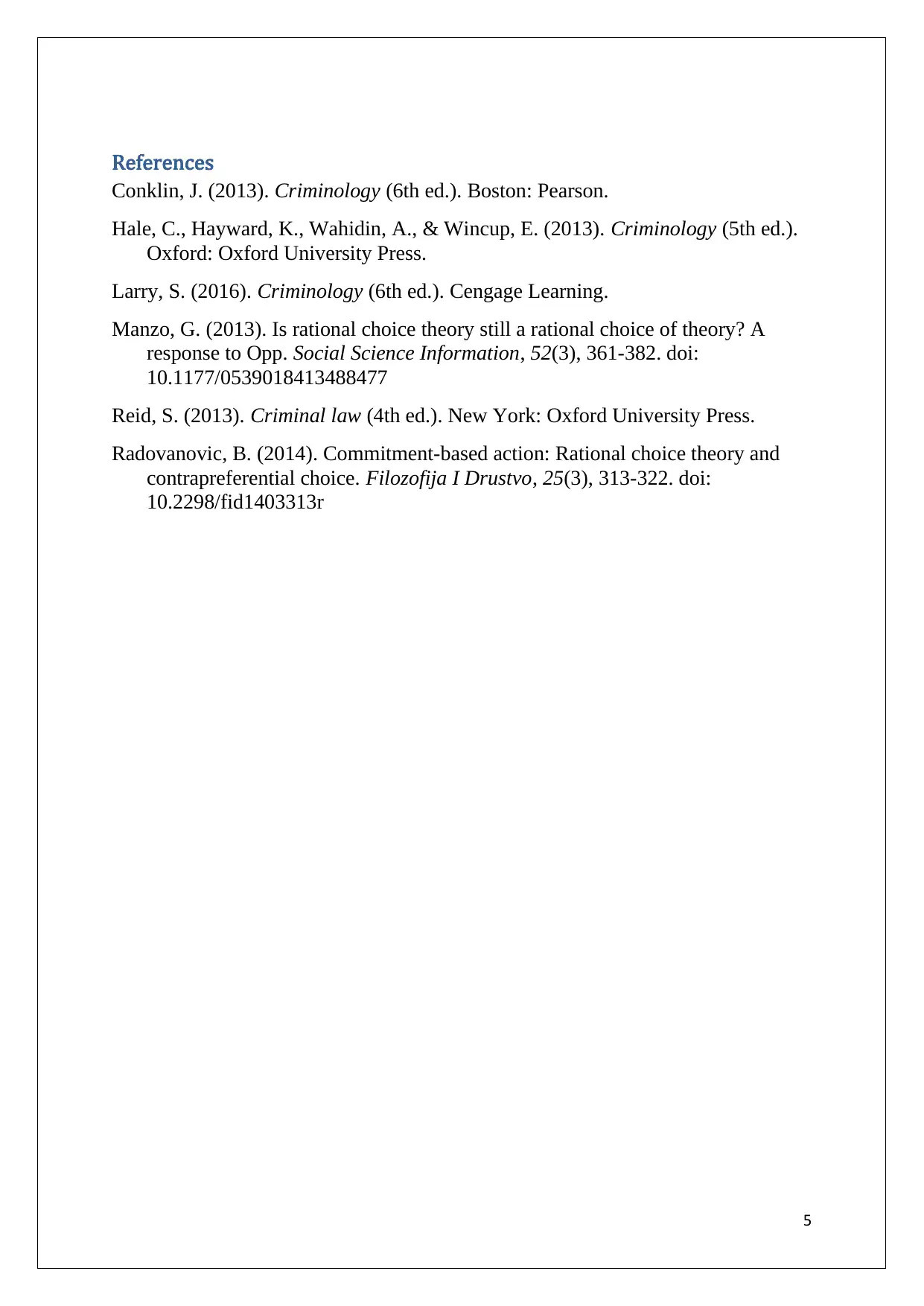CRIM1100 - S15: Rational Choice Theories and Violent Crime Analysis
VerifiedAdded on 2023/04/11
|6
|1645
|431
Essay
AI Summary
This essay explores the validity of rational choice theory in explaining violent crime. It begins with an introduction to the theory, emphasizing the idea that individuals commit crimes based on a cost-benefit analysis. The essay then delves into the body, examining the impact of punishment costs, economic costs (such as loss of legitimate income), and other costs like social stigma on criminal behavior. It presents research findings on the deterrent effect of punishment and the influence of employment and wages on offending. The essay also discusses how sociological factors contribute to the costs associated with crime, highlighting the importance of social sanctions and internalized norms. The conclusion reiterates the core tenets of rational choice theory, emphasizing that offenders make choices based on their perceptions of benefits and costs, and recommends considering the varying perspectives of individuals when analyzing criminal behavior.

Criminal Law
Paraphrase This Document
Need a fresh take? Get an instant paraphrase of this document with our AI Paraphraser

Table of Contents
Introduction...........................................................................................................................................2
Do choice theories provide a valid explanation for violent crime?........................................................2
Overview of the topic........................................................................................................................2
Body......................................................................................................................................................4
Punishment cost................................................................................................................................4
Economic cost....................................................................................................................................4
Other cost..........................................................................................................................................5
Conclusion.............................................................................................................................................6
References.............................................................................................................................................7
1
Introduction...........................................................................................................................................2
Do choice theories provide a valid explanation for violent crime?........................................................2
Overview of the topic........................................................................................................................2
Body......................................................................................................................................................4
Punishment cost................................................................................................................................4
Economic cost....................................................................................................................................4
Other cost..........................................................................................................................................5
Conclusion.............................................................................................................................................6
References.............................................................................................................................................7
1

Introduction
Rational choice theory is referred to as the set of ideas and concepts about the relationship
between the choices and preferences of an individual that he or she makes. The theory
assumes that human beings are self-interested and rational who are affected by the outcomes
of their actions. The theory states that criminal behavior does not differ from the non-criminal
behavior which means an individual intentionally commit a crime (Conklin, 2013). The main
reason for committing a crime is that people think that it would be less costly and more
rewarding in comparison to non-criminal behavior. The theory explains that the offenders are
not being compelled to committing crime because of certain extraordinary motivation. The
offenders do not possess different personalities in comparison to non-offenders and they are
also not socialized into the cultural system or criminal belief whose norms need crime. The
theory clearly explains that both non-criminal offenders and criminal offenders carry out their
actions on the basis of the benefits and costs associated with the intended action.
Research question
Do choice theories provide a valid explanation for violent crime?
Overview of the topic
The rational choice theory assists to provide a valid explanation for violent crime because
people commit crimes on the basis of their own choice. The theory is very much important to
understand because it provides explanations and assists to understand the criminal behavior
of an individual. The theory assumes that the choice of committing a crime by an individual
is being influenced by the factors that affect their decisions of behaving in an ethical manner.
Both law-abiding and law-violating behaviors show the desire for maximizing utility.
However, the choices are influenced by the attitudes toward time discounting and risk and
estimates of the availability, benefits, and costs of illegal opportunities. The preferences of
people are being influenced by the expected benefits from the results in relation to the costs.
The potential benefits are social, emotional and monetary and the costs are an opportunity,
sunk, external as well as social, emotional and monetary. Preferences are considered to be
stable and it does not change during the decision-making process but can be altered when
there is the availability of new information. An individual’s assessment of the costs and
benefits of results are influenced by the collected information. People prefer to collect all the
information before making any decision and choices are made on the basis of incomplete
information (Larry, 2016).
Inappropriate knowledge and information misguide an individual and they move towards the
wrong path. The preferences of individuals are also being influenced from time to time. The
time preferences are not considered to be fixed because other factors also influence decisions
such as the current level of the valued result of an individual. The preferences are also being
affected by the attitudes towards uncertainty and risk. The behavior is rational or not can be
understood by examining or making assumptions about the preferences, collected
information, risk-taking ability and time preference of an individual. The rational choices
made by an individual are due to the different behavior of an individual. The decisions can be
influenced negatively by the sudden change or intense emotion of an individual. Thus, the
rational choice theory is referred to as the consistency between the choices and preferences of
an individual (Manzo, 2013). The theory is being applied to violent crimes carried out by an
2
Rational choice theory is referred to as the set of ideas and concepts about the relationship
between the choices and preferences of an individual that he or she makes. The theory
assumes that human beings are self-interested and rational who are affected by the outcomes
of their actions. The theory states that criminal behavior does not differ from the non-criminal
behavior which means an individual intentionally commit a crime (Conklin, 2013). The main
reason for committing a crime is that people think that it would be less costly and more
rewarding in comparison to non-criminal behavior. The theory explains that the offenders are
not being compelled to committing crime because of certain extraordinary motivation. The
offenders do not possess different personalities in comparison to non-offenders and they are
also not socialized into the cultural system or criminal belief whose norms need crime. The
theory clearly explains that both non-criminal offenders and criminal offenders carry out their
actions on the basis of the benefits and costs associated with the intended action.
Research question
Do choice theories provide a valid explanation for violent crime?
Overview of the topic
The rational choice theory assists to provide a valid explanation for violent crime because
people commit crimes on the basis of their own choice. The theory is very much important to
understand because it provides explanations and assists to understand the criminal behavior
of an individual. The theory assumes that the choice of committing a crime by an individual
is being influenced by the factors that affect their decisions of behaving in an ethical manner.
Both law-abiding and law-violating behaviors show the desire for maximizing utility.
However, the choices are influenced by the attitudes toward time discounting and risk and
estimates of the availability, benefits, and costs of illegal opportunities. The preferences of
people are being influenced by the expected benefits from the results in relation to the costs.
The potential benefits are social, emotional and monetary and the costs are an opportunity,
sunk, external as well as social, emotional and monetary. Preferences are considered to be
stable and it does not change during the decision-making process but can be altered when
there is the availability of new information. An individual’s assessment of the costs and
benefits of results are influenced by the collected information. People prefer to collect all the
information before making any decision and choices are made on the basis of incomplete
information (Larry, 2016).
Inappropriate knowledge and information misguide an individual and they move towards the
wrong path. The preferences of individuals are also being influenced from time to time. The
time preferences are not considered to be fixed because other factors also influence decisions
such as the current level of the valued result of an individual. The preferences are also being
affected by the attitudes towards uncertainty and risk. The behavior is rational or not can be
understood by examining or making assumptions about the preferences, collected
information, risk-taking ability and time preference of an individual. The rational choices
made by an individual are due to the different behavior of an individual. The decisions can be
influenced negatively by the sudden change or intense emotion of an individual. Thus, the
rational choice theory is referred to as the consistency between the choices and preferences of
an individual (Manzo, 2013). The theory is being applied to violent crimes carried out by an
2
⊘ This is a preview!⊘
Do you want full access?
Subscribe today to unlock all pages.

Trusted by 1+ million students worldwide

individual. It assists to recognize that the choice of committing a crime by an individual may
not be rational.
Body
Punishment cost
The research of RCA has investigated the hypothesis and found that an increment in
punishment can decrease the case of offending. A little different effect can be found in
execution from the general finding. Though, there is evidence that whatever cost is attached
to imprisonment act is to discourage offending. A number of shortcomings can be noticed in
early studies however, more sophisticated method and advanced quality of the data is being
used by recent searchers for investigating the relationship. It is being found by the researchers
that an increment in imprisonment rates lead to a subsequent decrease in arrest rates (Reid,
2013). The finding of this research states that an increment in punishment can decrease the
case of offending.
However, the effect of the size is modest and incarcerates people's escalations might make
imprison a less prudent deterrent. In a recent investigation individuals data has been used and
also documented for disincentive effect of several, though it was not for all type of offending.
The research was conducted on inmates and it is being founded that there is a large
disincentive effect emerge from the punishment, and smaller, a negligible effect from the
severity of sections. Though, the effect of punishment is conditional. Effect of certainty is
considerable for whites and serious crimes but at the same time, it was declined for non-
serious offenses, Hispanics and blacks. It can be considered that the effect of severity is
positive for whites and at the same time negative for black.
Economic cost
It was being suggested by the RCA approach that loss of legitimate income can also become
a reason for offending. There was a research conducted on inmates report and it was being
found that there is a negative effect of legal income and at the same time a positive
relationship can also be noted between the length of a recent jobless spell and crime. A minor
complaint of criminal activity regarding employment was also found during the research
whereas a very few serious crime activities were associated. Consequently, the date of minor
cases and serious cases were being pulled in the research and it was being found that
employment hardly affects the criminal activity. The finding of this research states that a loss
of legitimate income can also become a reason for offending.
There was also another investigation that demonstrated the connection between offending and
decreased wages (Radovanovic, 2014). A comparable analysis was conducted and it was
found that opportunity and incentives for economic cost exert a strong effect on offending.
For an example, an offender can stop offending if legal earning will be increased and illegal
one decreased. Additionally, the distance can be encouraged from the number of post
convictions, the magnitude of this effect considered to be smaller in comparison to the legal
wages.
Other cost
There was a further contribution from the sociologist on the economic approach to the cost of
the crime by introducing a more effective approach to liabilities of crime. The stigma and
3
not be rational.
Body
Punishment cost
The research of RCA has investigated the hypothesis and found that an increment in
punishment can decrease the case of offending. A little different effect can be found in
execution from the general finding. Though, there is evidence that whatever cost is attached
to imprisonment act is to discourage offending. A number of shortcomings can be noticed in
early studies however, more sophisticated method and advanced quality of the data is being
used by recent searchers for investigating the relationship. It is being found by the researchers
that an increment in imprisonment rates lead to a subsequent decrease in arrest rates (Reid,
2013). The finding of this research states that an increment in punishment can decrease the
case of offending.
However, the effect of the size is modest and incarcerates people's escalations might make
imprison a less prudent deterrent. In a recent investigation individuals data has been used and
also documented for disincentive effect of several, though it was not for all type of offending.
The research was conducted on inmates and it is being founded that there is a large
disincentive effect emerge from the punishment, and smaller, a negligible effect from the
severity of sections. Though, the effect of punishment is conditional. Effect of certainty is
considerable for whites and serious crimes but at the same time, it was declined for non-
serious offenses, Hispanics and blacks. It can be considered that the effect of severity is
positive for whites and at the same time negative for black.
Economic cost
It was being suggested by the RCA approach that loss of legitimate income can also become
a reason for offending. There was a research conducted on inmates report and it was being
found that there is a negative effect of legal income and at the same time a positive
relationship can also be noted between the length of a recent jobless spell and crime. A minor
complaint of criminal activity regarding employment was also found during the research
whereas a very few serious crime activities were associated. Consequently, the date of minor
cases and serious cases were being pulled in the research and it was being found that
employment hardly affects the criminal activity. The finding of this research states that a loss
of legitimate income can also become a reason for offending.
There was also another investigation that demonstrated the connection between offending and
decreased wages (Radovanovic, 2014). A comparable analysis was conducted and it was
found that opportunity and incentives for economic cost exert a strong effect on offending.
For an example, an offender can stop offending if legal earning will be increased and illegal
one decreased. Additionally, the distance can be encouraged from the number of post
convictions, the magnitude of this effect considered to be smaller in comparison to the legal
wages.
Other cost
There was a further contribution from the sociologist on the economic approach to the cost of
the crime by introducing a more effective approach to liabilities of crime. The stigma and
3
Paraphrase This Document
Need a fresh take? Get an instant paraphrase of this document with our AI Paraphraser

rejection were included in the cost by company state sanctions, beliefs regarding the legal
system that it is just and moral, commitment towards normative values and shame and guilt
of punishments and violations of norms may induce. Vignettes have been used for research to
find many of these factors that are a better forecast of willingness to hurt someone in the near
future and that will increase the possibility of getting arrested. Additionally, individuals
might do some study that can help them in listing the potential cost of crime and can find a
wider array of concerns (Hale, Hayward, Wahidin & Wincup, 2013). The finding of this
research states that the economic approach contributed further to the cost of the crime by
introducing a more effective approach to liabilities of crime.
For an example, if an individual wants to know the cost of shoplifting substantial part
subjects reported covering bad karma for banishing from the shop and it is considered to be a
gateway act which might lead to some serious crime. A particular type of people often get
affected by social and state sanctions and those are individuals who own stake in society,
having norms of internalized that forbid offense and these are implemented in a network of
people who often obey and try to follow the law most of the time and there experience of
criminal activities are also limited to small offense. These people could make greatest effect
on those who has reason and motivation to commit crime. A research was also conducted on
homeless youth and it was being found that they are engaged in different type of criminal
cost.
Conclusion
The rational choice theory clearly shows that an offender is rational and chooses for
committing crime on the basis of his own decision that it would be profitable or rewarding or
satisfy certain needs. The theory depicted that criminal and non-criminal behavior is not
different rather it the choice of an individual to commit a crime. The understanding of the
criminal decision-making process can assist to examine how an individual makes a decision
in general. However, it is being found that people who commit a crime may have various
preferences. It is being recommended that assuming all the people have the same thinking or
choices is not right. The choices may vary and people may consider benefits and costs
incurred from the actions in a different manner. It is also being found the decision of
committing a crime may be chosen strategically on the basis of the opinions of others. It is
being recommended that the choices may depend on other factors also.
4
system that it is just and moral, commitment towards normative values and shame and guilt
of punishments and violations of norms may induce. Vignettes have been used for research to
find many of these factors that are a better forecast of willingness to hurt someone in the near
future and that will increase the possibility of getting arrested. Additionally, individuals
might do some study that can help them in listing the potential cost of crime and can find a
wider array of concerns (Hale, Hayward, Wahidin & Wincup, 2013). The finding of this
research states that the economic approach contributed further to the cost of the crime by
introducing a more effective approach to liabilities of crime.
For an example, if an individual wants to know the cost of shoplifting substantial part
subjects reported covering bad karma for banishing from the shop and it is considered to be a
gateway act which might lead to some serious crime. A particular type of people often get
affected by social and state sanctions and those are individuals who own stake in society,
having norms of internalized that forbid offense and these are implemented in a network of
people who often obey and try to follow the law most of the time and there experience of
criminal activities are also limited to small offense. These people could make greatest effect
on those who has reason and motivation to commit crime. A research was also conducted on
homeless youth and it was being found that they are engaged in different type of criminal
cost.
Conclusion
The rational choice theory clearly shows that an offender is rational and chooses for
committing crime on the basis of his own decision that it would be profitable or rewarding or
satisfy certain needs. The theory depicted that criminal and non-criminal behavior is not
different rather it the choice of an individual to commit a crime. The understanding of the
criminal decision-making process can assist to examine how an individual makes a decision
in general. However, it is being found that people who commit a crime may have various
preferences. It is being recommended that assuming all the people have the same thinking or
choices is not right. The choices may vary and people may consider benefits and costs
incurred from the actions in a different manner. It is also being found the decision of
committing a crime may be chosen strategically on the basis of the opinions of others. It is
being recommended that the choices may depend on other factors also.
4

References
Conklin, J. (2013). Criminology (6th ed.). Boston: Pearson.
Hale, C., Hayward, K., Wahidin, A., & Wincup, E. (2013). Criminology (5th ed.).
Oxford: Oxford University Press.
Larry, S. (2016). Criminology (6th ed.). Cengage Learning.
Manzo, G. (2013). Is rational choice theory still a rational choice of theory? A
response to Opp. Social Science Information, 52(3), 361-382. doi:
10.1177/0539018413488477
Reid, S. (2013). Criminal law (4th ed.). New York: Oxford University Press.
Radovanovic, B. (2014). Commitment-based action: Rational choice theory and
contrapreferential choice. Filozofija I Drustvo, 25(3), 313-322. doi:
10.2298/fid1403313r
5
Conklin, J. (2013). Criminology (6th ed.). Boston: Pearson.
Hale, C., Hayward, K., Wahidin, A., & Wincup, E. (2013). Criminology (5th ed.).
Oxford: Oxford University Press.
Larry, S. (2016). Criminology (6th ed.). Cengage Learning.
Manzo, G. (2013). Is rational choice theory still a rational choice of theory? A
response to Opp. Social Science Information, 52(3), 361-382. doi:
10.1177/0539018413488477
Reid, S. (2013). Criminal law (4th ed.). New York: Oxford University Press.
Radovanovic, B. (2014). Commitment-based action: Rational choice theory and
contrapreferential choice. Filozofija I Drustvo, 25(3), 313-322. doi:
10.2298/fid1403313r
5
⊘ This is a preview!⊘
Do you want full access?
Subscribe today to unlock all pages.

Trusted by 1+ million students worldwide
1 out of 6
Related Documents
Your All-in-One AI-Powered Toolkit for Academic Success.
+13062052269
info@desklib.com
Available 24*7 on WhatsApp / Email
![[object Object]](/_next/static/media/star-bottom.7253800d.svg)
Unlock your academic potential
Copyright © 2020–2025 A2Z Services. All Rights Reserved. Developed and managed by ZUCOL.





